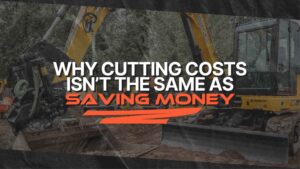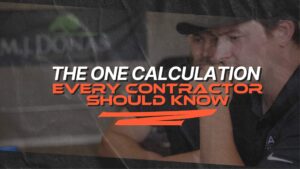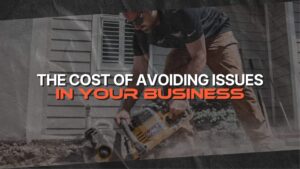What's a Healthy Profit Margin for a Landscaping Business?

Healthy Profit Margin?
If you’re running a landscape company, there are a couple of things that might make you ask what a healthy profit margin is.
Maybe you keep getting “no’s” on quotes you’re sending out to clients. Making you wonder if you’re charging too much.
Or maybe you’re quoting a bigger job than you’ve ever quoted before, and now you’re wondering if you should reduce the profit margin because the profit number is bigger than you’ve ever bagged in one shot.
Or maybe you’re trying to scale your business, and dumping all your profit back into funding your growth, and wonder just how much to add for profit margin.
I have helped hundreds of businesses build their budgets and financial projections, and here’s the short version of the story:
- 10% net profit margin is the lowest acceptable floor
- 15-20% is the goal
- 20%+ can help you scale more quickly without using debt
Net Profit or Gross?
Note that I’m referring to net profit, not gross profit. What’s the difference?
Gross Profit
Gross profit is what is left after you’ve deducted all labor, material, and subcontractor expenses from the job revenue. But you haven’t yet paid your overhead expenses, like marketing, insurance, owner’s salary, utilities, office admin, etc.
Net Profit
Net profit is what is left after you’ve paid all those expenses too. There literally is not another bill left to pay.
Depending on your business model, you could have high gross profit and low net. Or low gross profit and acceptable net.
ie Business 1 has a 50% gross profit but only 5% net. (I’ve seen it)
or Business 2 has 35% gross and 15% net.
What makes that happen?
Typically the Business 1 example has too much overhead burden for the size of the company they are. This could be things like too much staff on the admin/overhead side, too much investment in equipment/trucks, etc. If you’re doing $1m in revenue, but have $500k in annual overhead expenses. Generally speaking, that’s too high to be healthy. They’d need to be cranking out $1.5-$2m in revenue to be able to justify that level of overhead expense.
In the Business 2 example, maybe they aren’t even that big. Let’s say $500k in revenue. But they also run lean and mean on overhead expenses. They don’t have a lot of cash wrapped up in overhead expenses and leverage technology, automation, and processes to run an efficient operation, saving on labor and overhead staff needs. This has the effect of lowering overhead costs.
I saw a study recently that stated the average net profit for landscape businesses was 2%-6%. From what I’ve seen firsthand helping landscape businesses dial in their budget and pricing for their estimates, sadly it seems to be more likely than not to be true.
Building the budget
When we help landscape companies build budgets, the lowest I let the net profit go is 10%. Anything lower than that is just too razor-thin. 10% on a $500k business is $50k in annual profit. It doesn’t take too many estimating mistakes to wipe that out. (This is why it’s key to know your own numbers and price your jobs based on your own numbers) It also doesn’t provide a ton of capital to invest back into the business to grow it. Leaving you with either stagnated growth or debt-funded growth. I prefer cash-funded growth 🙂.
15%-20% is comfortable and gives you a little more wiggle room, and could allow you as the owner to take some profit home, plus leave a little in the business to fund growth.
20%+ is really helpful to fast-growing businesses. When you grow fast, it just takes cash, plain and simple. Hiring overhead staff, buying equipment, marketing, all of it is happening in rapid growth, and it takes dollars. The other thing to keep in mind is, your direct costs + overhead expenses + 10% profit margin is your floor. Meaning you can’t charge less than that on a quote. But the only thing that dictates the ceiling of that profit % is the market. If you can still sell the job, you haven’t hit your ceiling yet.
Know your numbers
So in all of this, as you can see, it’s really important to understand your own numbers. If you never sat down to tally up your overhead expenses, you could be applying a 20% margin to your estimates for net profit, but end up with 0% profit. How? Well, I’ll tell you a story.
I had a conversation recently with new landscape business owners in startup mode, in their second or third season. They were doing the math, figuring out their costs, and their overhead, and then adding their profit to that. But when we investigated their numbers and went over their overhead with a fine-tooth comb, we discovered that their true overhead expenses were almost double what they had figured.
This meant that the profit margin they were adding to their quotes was getting sucked right back out to pay those overhead expenses. Leaving them with a breakeven, and in some cases, even a loss.
The reason I tell you this story is this: The number you are plugging in as your profit margin on your quotes means nothing if you don’t know your costs.
A symptom of this is when you are adding a 20% net profit margin to your quotes when you bid, but only seeing 0-10% in your actual Profit & Loss statement at the end of the year.
Where’s the difference? Where did that cash go?
In my experience, it’s almost always in unaccounted-for overhead expenses.
Those overhead expenses are sneaky. It’s easy to spend money and forget to update and adjust your overhead recovery numbers in your quoting.
What I’m saying
So, the point I’m trying to make is, let’s make sure the net profit margin you use on quotes actually ends up in profit dollars that you can either take home as the owner or choose to reinvest into the company.
Let’s squash the issue of using 20% margins on quotes, but only having single digits left at the end of the year.
You can build a company budget for free on the SynkedUP website, which will allow you to plug all your expenses in, and spits your pricing back out. Meaning it shows you what percentage to mark up to recover overhead so you can arrive at your true breakeven. When adding your profit margin to what truly actually is your breakeven, then you actually end up getting the money that was in your profit margin on your quote.
Building a budget is not a one-and-done thing though. I like to scan back over my budget at least monthly and update and tweak my costs and overhead expenses so that the next quote going out the door is based on the most up-to-date costs.
Good luck! If you’d like to meet with me or one of the experts on my team and have us look over your budget, man-hour rates, and margins, then just book a call at this link. I love talking about this stuff and dialing these things in!
Hit reply and drop me any questions that pop up in your head!
Cheers!
Weston Zimmerman

Weston Zimmerman
CEO and co-founder
See SynkedUP in action
Related Articles
Tips To: Improve Client Experience
Cutting costs isn't the same as saving money. Learn how to use leverage, not panic, to drive real profit and...
What is the Most Difficult Challenge You’ve Overcome?
Cutting costs isn't the same as saving money. Learn how to use leverage, not panic, to drive real profit and...
Why Time Tracking is Critical for Contractors
Cutting costs isn't the same as saving money. Learn how to use leverage, not panic, to drive real profit and...
Why Cutting Costs Isn’t the Same as Saving Money
Cutting costs isn't the same as saving money. Learn how to use leverage, not panic, to drive real profit and...
Slow Down to Speed Up
A quick leadership gut check: Are you building what really matters? Slow down, realign, and lead with intention.
The One Calculation Every Contractor Should Know
Contractors: If you’re not factoring in overhead, you're not pricing right. Learn how to calculate breakeven and stop guessing your...
What Owns Your Day? Urgency or Importance?
Stuck in a cycle of chaos and urgent tasks? Break the cycle with better systems, clear processes, and leadership that...
Taking Care of Your Team
Leadership isn't barking orders - it's listening, appreciating, and building problem solvers. Here's how to lead without burning out.
The Cost of Avoiding Issues in Your Business
Avoiding stuff in business adds up, with interest. Don't try harder, build systems that make success default. Do hard things,...
Leveraging Your Job Data for More Accurate Estimates
Stop estimating from the gut. Track time, collect job data, and turn it into faster, more accurate production rates.









